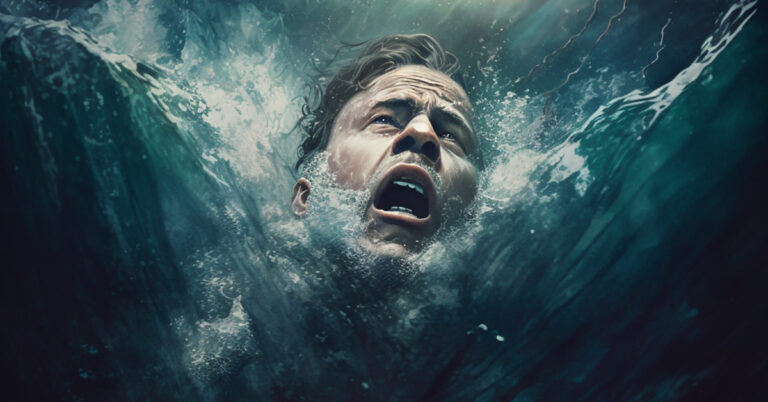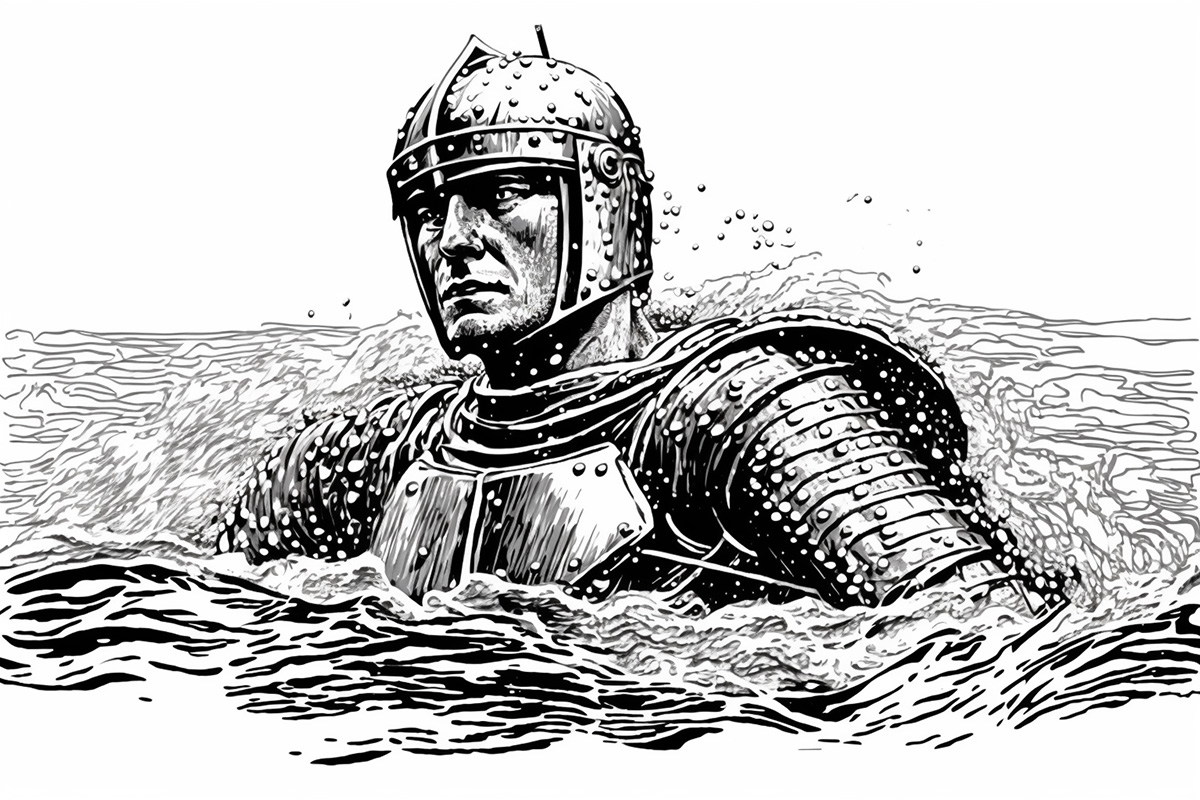Whether you’ve fallen off the ship into rough seas, been enveloped by a particularly Gelatinous Cube, or just fallen unconscious face-first into a puddle, you’re probably going to be drowning. But how exactly does that work?
Table of Contents
How does drowning work in DnD 5e?
Drowning rules in DND 5e are closely related to suffocating because they follow the same basic principles. According to the suffocation rule in Chapter 8 of The Player’s Handbook, creatures only have a limited amount of time to hold their breath and swim back to the surface before their hit points drop to zero.
DND 5e drowning rules
The official rule is as follows:
“A creature can hold its breath for a number of minutes equal to 1 + its Constitution modifier (minimum of 30 seconds).
When a creature runs out of breath or is choking, it can survive for a number of rounds equal to its Constitution modifier (minimum of 1 round). At the start of its next turn, it drops to 0 hit points and is dying, and it can’t regain hit points or be stabilized until it can breathe again.”
If you’re still feeling a little lost, don’t worry! Instead, let’s break this rule down so we can examine what it means.
How long can you stay underwater or hold your breath in 5e?
The number of minutes you can hold your breath for is equal to your Constitution modifier +1. For those creatures with a Constitution lower than 10 that have a negative modifier, a 30-second rule applies. No matter what your Constitution is, all creatures can hold their breath for at least 30 seconds.
At the other end of the sale, a Constitution of 20 gives a +5 bonus, meaning a character with a 20 Constitution score could hold their breath for 6 minutes.
| Constitution | Maximum breath hold time | Maximum breath hold rounds |
| Less than 10 | 30 seconds | 5 rounds |
| 10 (+0 modifier) | 1 minute | 10 rounds |
| 11 (+0 modifier) | 1 minute | 10 rounds |
| 12 (+1 modifier) | 2 minutes | 20 rounds |
| 13 (+1 modifier) | 2 minutes | 20 rounds |
| 14 (+2 modifier) | 3 minutes | 30 rounds |
| 15 (+2 modifier) | 3 minutes | 30 rounds |
| 16 (+3 modifier) | 4 minutes | 40 rounds |
| 17 (+3 modifier) | 4 minutes | 40 rounds |
| 18 (+4 modifier) | 5 minutes | 50 rounds |
| 19 (+4 modifier) | 5 minutes | 50 rounds |
| 20 (+5 modifier) | 6 minutes | 60 rounds |
Running out of breath
The next important part of this rule is what happens when creatures or characters run out of breath. When your character can’t hold their breath anymore, they effectively start drowning. But creatures still have time to try and get back to precious life-giving air.
Depending on their Constitution score, creatures will have at least one more round to try and save themselves from drowning. The Handbook states they can survive for the “number of rounds equal to their Constitution modifier.” So, the number of rounds or seconds they have to breach the water’s surface is directly linked to their Constitution.
This means any character with a Constitution score below 14 is going to get a single turn (6 seconds) to get out of their jam, whereas hardy creatures with a Constitution of 20 have 5 turns (30 seconds).
If your character fails to make get to a breathable place again before their downing time is up, their hit points are set to 0.
| Constitution | Maximum drowning time | Maximum drowning rounds |
| Less than 14 | 6 seconds | 1 round |
| 14 (+2 modifier) | 12 seconds | 2 rounds |
| 15 (+2 modifier) | 12 seconds | 2 rounds |
| 16 (+3 modifier) | 18 seconds | 3 rounds |
| 17 (+3 modifier) | 18 seconds | 3 rounds |
| 18 (+4 modifier) | 24 seconds | 4 rounds |
| 19 (+4 modifier) | 24 seconds | 4 rounds |
| 20 (+5 modifier) | 30 seconds | 5 rounds |
How much damage does drowning do?
Technically, drowning doesn’t do any damage to a creature. Instead, if the creature runs out of breath, and then exceeds the number of rounds it can stay conscious, its hit points will simply drop to 0 and it will be unconscious and become incapacitated.
Here’s the rub though: If you’re still underwater at this point, you will automatically fail your death saves. If your allies can’t pull you out before your third death save, you’re fish food! So it’s important for your party to work quickly. If an ally can pull you out of the water before your third failed death save, you’ll have the chance to be stabilised.
Does drowning hurt armour?
Drowning doesn’t hurt a character’s armour, it is worth taking into consideration. While there are no rules written regarding swimming with armour, if your character is wearing heavy armour, the chances are your DM is going to take this into consideration, meaning they may well sink much quicker and, probably, die much quicker. Your mileage (below the sea) may vary.
Heavy armour: Great for deflecting arrows, not so great for staying afloat
Can you breathe underwater in DnD?
There are various ways to traverse the depths with either the ability to breathe underwater or, negating the need to breathe at all.
5e races/species that can breathe underwater
- Sea Elf
- Simic Hybrid (if Underwater Adaptation is selected as part of Animal Enhancement)
- Triton
- Water Genasi
5e races/species do not need to breathe underwater
- Air Genasi (can hold breath indefinitely while not incapacitated)
- Warforged (doesn’t need to breathe)
5e races/species that can hold their breath for extended periods of time
- Lizardfolk (15 minutes)
- Tortle (1 hour)
- Vedalken (1 hour once per long rest)
5e spells and potions that can help you breathe underwater
- A spell, potion or scroll of water breathing
- A polymorph spell or scroll to turn into sea creatures
- Druid Wild Shape
5e items that can help you breathe underwater
Can you talk or cast spells underwater?
Usually, DMs will allow players to speak underwater with a water-breathing effect. This is because the rules as written state the only thing stopping characters from conversing or using verbal components underwater is their need to breathe, so without this need, they should be able to speak.
This does of course mean before this effect is in place, spellcasting will with verbal components not be possible unless the spellcaster has meta magic such as the Sorcerer’s Silent Spell.
The last breath
Hopefully, this guide will keep you out of a watery grave, but understanding the rules of drowning and suffocation can give you the situational edge that you can use to your advantage. Know you’ve got a better constitution than your enemy? If you’re both underwater, they’re going down first! Got some water-breathing possibilities? Any body of water can be your escape route!

